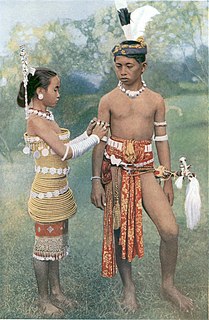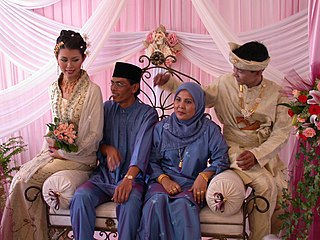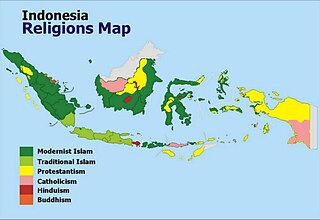
The Dayak or Dyak or Dayuh are the native people of Borneo. It is a loose term for over 200 riverine and hill-dwelling ethnic subgroups, located principally in the central and southern interior of Borneo, each with its own dialect, customs, laws, territory and culture, although common distinguishing traits are readily identifiable. Dayak languages are categorised as part of the Austronesian languages in Asia. The Dayak were animist in belief; however, many converted to Islam and since the 19th century there has been mass conversion to Christianity. Today most Dayak still follow their ancient animistic traditions, but often state to belong to one of the 6 recognized religions in Indonesia.

South Kalimantan is a province of Indonesia. It is located in Kalimantan, the Indonesian territory of Borneo. The provincial capital is Banjarmasin. The population of South Kalimantan was recorded at just over 3.625 million people at the 2010 Census; the latest official estimate is 4,119,794. One of five Indonesian provinces in Kalimantan, it is bordered by the Makassar Strait in the east, Central Kalimantan in the west and north, the Java Sea in the south, and East Kalimantan in the north. The province also includes the island of Laut, located off the eastern coast of Kalimantan. The province is divided into 11 regencies and 2 cities. South Kalimantan is the traditional homeland of the Banjar people, although there are some part of East Kalimantan and Central Kalimantan that is also included in this criteria. Nevertheless, South Kalimantan, especially the capital city Banjarmasin has always be the cultural capital of Banjarese culture. Many Banjarese has migrated to other parts of Indonesia, as well as neigbouring countries such as Singapore and Malaysia. In addition, other ethnic groups also inhabit the province, such as several group of the Dayaks, who mostly live in the interior part of the province, as well as the Javanese, who mostly migrated from Java due to the Transmigration program which dated from the Dutch colonial era.

Bidayuh is the collective name for several indigenous groups found in southern Sarawak, Malaysia and northern West Kalimantan, Indonesia, on the island of Borneo, that are broadly similar in language and culture. The name Bidayuh means 'inhabitants of land'. Originally from the western part of Borneo, the collective name Land Dayak was first used during the period of Rajah James Brooke, the White Rajah of Sarawak. At times they were also lesser referred to as Klemantan people. They constitute one of the main indigenous groups in Sarawak and West Kalimantan and live in towns and villages around Kuching and Samarahan in the Malaysian state of Sarawak, while in the Indonesian province of West Kalimantan they are mainly concentrated in the northern Sanggau Regency. In Sarawak, most of Bidayuh population are found within 40 km of the geographical area known as Greater Kuching, within the Kuching and Samarahan division. They are the second largest Dayak ethnic group in Sarawak after the Iban and one of the major Dayak tribes in West Kalimantan.

Malay Singaporeans or Singaporean Malays, are defined by the Government of Singapore and by intellectuals in the country using the broader concept of the Malay race, including ethnic Malays and related ethnic groups. Although the Malays are indigenous to the area that is now Singapore, and with established political rule recorded as early as the 13th century AD, most Malays in Singapore today include roots from present-day Malaysia, Brunei and Indonesia. Prior to the arrival of Raffles, there were many of the indigenous Malays living on the island under the Johor Sultanate. Most of the indigenous Malays came from the Malay Archipelago. As of 2015, Malay Singaporeans constitute 15% of the country's citizens, making them the second largest ethnic group in Singapore.

Jakun people or Orang Ulu / Orang Hulu are an ethnic group recognised as Orang Asli of the Malay Peninsula in Malaysia.

Punan Ba or Punan is an ethnic group found in Sarawak, Malaysia and in Kalimantan, Indonesia. The Punan Bah people are distinct and unrelated to the semi-nomadic Penan people. Their name stems from two rivers along the banks of which they have been living since time immemorial. They do have other names: Mikuang Bungulan or Mikuang and Aveang Buan. But those terms are only used ritually these days.

The Semai are a semi sedentary ethnic group living in the center of the Malay Peninsula in Southeast Asia, known especially for their nonviolence. They speak Semai, an Austroasiatic language closely related to Temiar, spoken by Temiars nearby. The Semai are bordered by the Temiars to the north and the Jah Hut to the South. The Semai belong to the Senoi group, and are one of the largest indigenous ethnic group in the Peninsula and the largest of the Senoi group. Most Semai subsist by cultivating grain crops, hunting, and fishing.

Banjar is an Austronesian language spoken by the Banjar people of South Kalimantan province of Indonesia. Since the Banjarese were historically nomadic merchants, Banjarese has been spoken throughout modern Indonesia and the Malay world.

Christianity is Indonesia's second-largest religion, after Islam. Indonesia also has the second-largest Christian population in Southeast Asia after the Philippines, the largest Protestant population in Southeast Asia, and the fourth-largest Christian in Asia after the Philippines, India and China. Indonesia's 24 million Christians constitute 10% of the country's population, with 7% Protestant and 3% Catholic. Some provinces in Indonesia are majority Christian.
The Duano' are one of the indigenous peoples of Malaysia and can be found in islands along the northeastern region of Sumatra, Indonesia in which most Duano' people lived. They are considered to be Proto-Malay. Duano' people are also categorized as Orang Laut or migratory fishermen; a group that includes the Urak Lawoi’ people and Moken people of the northern region. Among the Orang lauts they are counted only by the peculiarities of the way of life, and so they are a completely separate ethnic group with their own language, culture, self-consciousness and economic complexities, to of which they themselves deny that they belonged to the Orang laut. With their normadic boat lifestyle, their livelihood is almost exclusively based on fishing, and collecting shellfish and crustaceans by using mud-boards.

Apa Khabar Orang Kampung is a 2007 Malaysian documentary by Amir Muhammad. It was produced by Da Huang Pictures. Like its predecessor The Last Communist, it was banned in its home country but screened in several international film festivals. It premiered at the Berlinale in 2006.

Ma'anyan, Dayak Maanyan or Eastern Barito Dayak people are a sub-ethnic group of the Dayak people indigenous to Borneo. They are also considered as part of the east Barito Dusun group with the name Dusun Ma'anyan. According to J. Mallinckrodt (1927), the Dusun people group is part of the Ot Danum people cluster, although later that theory was disproved by A. B. Hudson (1967), who argues that the Ma'anyan people are a branch of the Barito family. The Ma'anyan people who are often referred to as Dayak people are also referred to as Dayak Ma'anyan. The Dayak Ma'anyan people inhabit the east side of Central Kalimantan, especially in the East Barito Regency and parts of South Barito Regency which are grouped as Ma'anyan I. The Dayak Ma'anyan people also inhabit the northern parts of South Kalimantan, especially in Tabalong Regency which refers to the Dayak Warukin people. The Dayak Balangan people or Dusun Balangan people which are found in the Balangan Regency and the Dayak Samihim people that are found in the Kotabaru Regency are grouped together with the Dayak Ma'anyan people group. The Dayak Ma'anyan people in South Kalimantan are grouped as Ma'anyan II.
Orang Kanaq are one of the 18 Orang Asli ethnic groups in Malaysia. They are classified under the Proto-Malay people group, which forms the three major people group of the Orang Asli. The Orang Kanaq are considered as the smallest Orang Asli group with the population of approximately 90 people only.
Sarawak's population is very diverse, comprising many races and ethnic groups. Sarawak has more than 40 sub-ethnic groups, each with its own distinct language, culture and lifestyle. This makes Sarawak demography very distinct and unique compared to its Peninsular counterpart.

Orang Seletar are one of the 18 Orang Asli ethnic groups in Malaysia. They are classified under the Proto-Malay people group, which forms the three major people group of the Orang Asli. The Orang Seletar are also considered as part of the Orang Laut, natives of the Straits of Johor; separating Singapore from Peninsula Malaysia.
The Iu Mien people are a Southeast Asian subset of the Yao people, a minority group originally from China. Displaced by the Vietnam War, many settled in the United States from the late 1970s to the mid 1990s. From China, the Iu Mien migrated to Vietnam, Laos and Thailand. They speak the Iu Mien language.

A kampong or kampung is a village in Brunei, Indonesia, Malaysia and Singapore and a "port" in Cambodia. The term applies to traditional villages, especially of indigenous people, and has also been used to refer to urban slum areas and enclosed developments and neighbourhoods within towns and cities in Malaysia, Indonesia, Singapore, Cambodia, Sri Lanka and Christmas Island. The traditional kampong village designs and architecture have been targeted for reform by urbanists and modernists and have also been adapted by contemporary architects for various projects. Traditional kampongs are also a tourist attraction.
This is a list of events in 2016 in Indonesia.

















